Do you want to connect with the world’s wildlife, but don’t know how to do it ethically? Swimming with whale sharks in the Philippines, riding elephants or posing for pictures with tigers in Thailand may sound amazing — until you see or learn about the harsh conditions you may unintentionally support.
Fortunately, it’s possible to interact with local wildlife in a way that protects, conserves and enhances their existence, as long as you know where to go.
Epicure & Culture has rounded up the best ethical vacations for animal lovers around the world. All of these wildlife vacations will educate you about relevant issues and promote animal and environmental conservation — not to mention many of them allow you to volunteer with the animals. All of these experiences will transform the way you understand the interaction between man and wildlife.
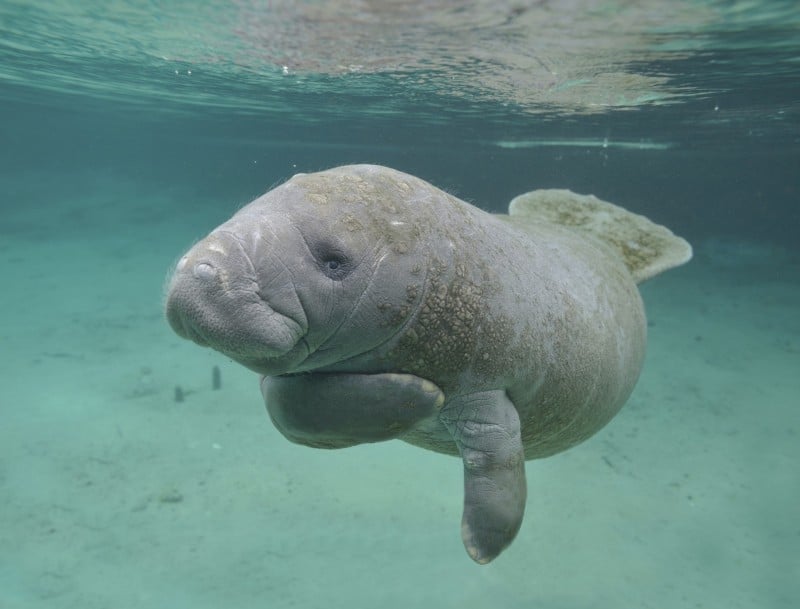
Manatee. Photo courtesy of Discovery Corps.
1) Have A Caribbean Manatee Adventure In Belize
Discover Corps combines meaningful volunteerism, cultural immersion and engaging exploration, including “vacations with a purpose” that support wildlife conservation. They partner with non-profit organizations to design a well-balanced program that allow travelers to get below the surface, purposefully experience a country and make a positive impact. Travel with them and work with endangered manatees in Belize, a land of coral fringed islands, the world’s second largest barrier reef and pristine rainforests.
You will spend part of your eight-day trip counting the population of the West Indian Manatee, monitoring their health and measuring key environmental factors. This crucial information will help people track these gentle creatures, who will in turn teach you about current conservation initiatives. You will also visit sandy beaches, colorful reefs and verdant jungles with hiking, swimming, kayaking and boating excursions. Discover the Mayan culture of Belize by visiting ancient ruins and spending an afternoon with an indigenous family making tortillas and cocoa as well as trying local instruments.
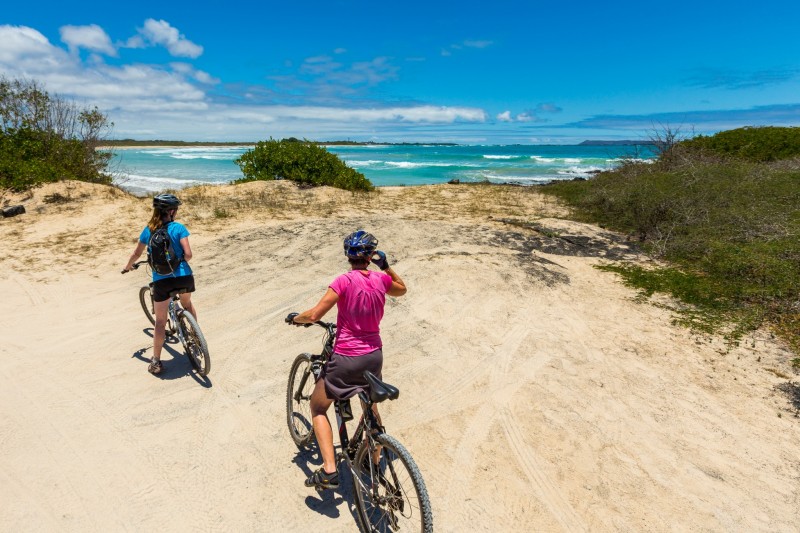
Galapagos Volunteer Vacation with REI adventures. Photo courtesy of REI Adventures.
2) Volunteer With Sea Turtles In The Galapagos Islands, Ecuador
The tropical climate and lack of natural predators in the Galapagos Islands has created an unparalleled assortment of wildlife, including the giant tortoise, penguins and marine iguanas, some of which are found nowhere else on the planet. The Galapagos is a mecca for wildlife enthusiasts worldwide, and REI Adventures connects travelers with volunteer opportunities that support the wildlife and habitat that makes the region so special. They partner with Conservation Volunteers International Program to create a Galapagos Islands Volunteer Vacation.
On this 11-day trip you will explore San Cristóbal and Isabela islands. You can make a real difference by gathering data about local turtle populations to support a research project led by Dr. Judith Denkinger. You will restore habitats and protect one of the world’s most extraordinary ecosystems, as well as actively explore the island through hiking, mountain biking and snorkeling with many opportunities to closely observe the wildlife, including giant tortoise, marine iguana, and penguins.

Volunteer at Senda Verde Animal Refuge. Photo courtesy of Tracey Buyce
3) Volunteer At An Animal Refuge In Yungas, Bolivia
One of the best places to work with wildlife in South America is at Senda Verde Animal Refuge and Eco-Resort in Yungas, Bolivia. Visitors tend to turn short visits into long stays because they fall in love with the animals and the work. The privately owned refuge happily welcomes volunteers, whether they can stay a couple weeks or months.
Participate in a rotational program working with rescued parrots, macaws, turtles, tortoises, bears, wild cats and monkeys. Primate lovers can act as substitute parents, caring for orphaned baby monkeys who need physical contact to survive. You can also take part in the “care bear” program, working with two rare Andean Spectacled Bears named Aruma and Tipnis.
Conveniently, the refuge has an ecotourism resort and restaurant onsite. The property uses solar ovens to prepare food for the animals, collects and transports recyclable materials to be reused, and purchases local products when possible. They are also working with local farmers to plant new native trees and combat deforestation in the area.

Africat health team. Photo courtesy of Wilderness Travel.
4) Help Veterinarians & Learn About Desert Lions In Namibia
Stand on the front lines of conservation with this unique opportunity to participate in veterinary checks of desert cats, with a portion of your trip directly benefiting appropriate efforts. Wilderness Travel provides an intimate experience for six travelers at a time to work with an international team of veterinaries and local experts.
Visit the renowned Desert Rhino Camp to understand how local research efforts help to ensure the survival of the black rhino. You will learn about the work of Dr. Flip Stander, an expert on the elusive desert lion, who spent many years isolated in the desert to accumulate this knowledge. June travelers can assist veterinarians in an annual medical check, including the weighing, measuring and vaccinating of leopards, cheetahs and lions.

Elephant Valley Nature Project. Photo courtesy of Vin Kebblewhite of Journeys Within Tour Company.
5) Experience A Cambodia Conservation Tour
Journeys Within wants to help you get to know Cambodia’s most beautiful sights while actively promoting the conservation of the species and places that make it special. Since some travelers want to see animals, they’ve partnered with organizations dedicated to conservation and humane treatment of animals so their customers can do this in an ethical manner.
On the Cambodia Conservation Tour, visit highlights of the country with wildlife visits interspersed throughout the itinerary. For example, in Phnom Penh you’ll explore national monuments and war memorials as well as the world’s biggest Sun Bear sanctuary. Leaving the big city, visit the Elephant Valley Project and hear stories of their nine beautiful residents who are able to roam in a natural habitat, free from poachers. Next, you’ll get to know the forest environment with an exciting zip line tour before heading to the Mekong River and meeting the critically endangered Irrawaddy dolphins in their natural habitat. These are just a few experience examples.

Brazilian jaguar on the prowl. Photo courtesy of Wild Planet Adventures.
6) Spot Jaguars In The Pantanal Of Brazil
Demands from tourists eager to see jaguars in the wild at a low cost has pressured Brazilian operators to stoop to unsustainable practices, including baiting, radio collaring and allowing multiple boat viewings at once in Puerto Joffre. This acclimates jaguars to human presence so they begin exhibit behaviors as if they were in a zoo instead of in the wild.
As a sustainable alternative, Wild Planet Adventures takes you to the Taiama Reserve, not easily accessed by budget do-it-yourself travelers. Tourists and the public cannot enter this federally protected Ecological Station itself, but you can circumnavigate the island reserve in search of the elusive jaguar who often hunt caiman by the river. Wild Planet Adventures utilizes biologist guides with strict sustainable protocols, averaging about 1.5 jaguar sightings a day in this area. This high volume of quality sightings proves that jaguar tourism can exist sustainably thanks to protocols such as banning the use of radios, using highly trained biologist guides with strict viewing protocols, and limiting boats to one-at-a-time. Furthermore, instead of jaguars habituated to human presence, these jaguars around Taiama are alert, active and exhibit authentic behaviors consistent with wild animals in their natural habitat.
The rest of this action-packed itinerary includes other sustainable animal interactions like tracking anacondas, horseback riding through a private animal reserve, going on bird walks through woodlands and hiking through the rainforest looking for primates.
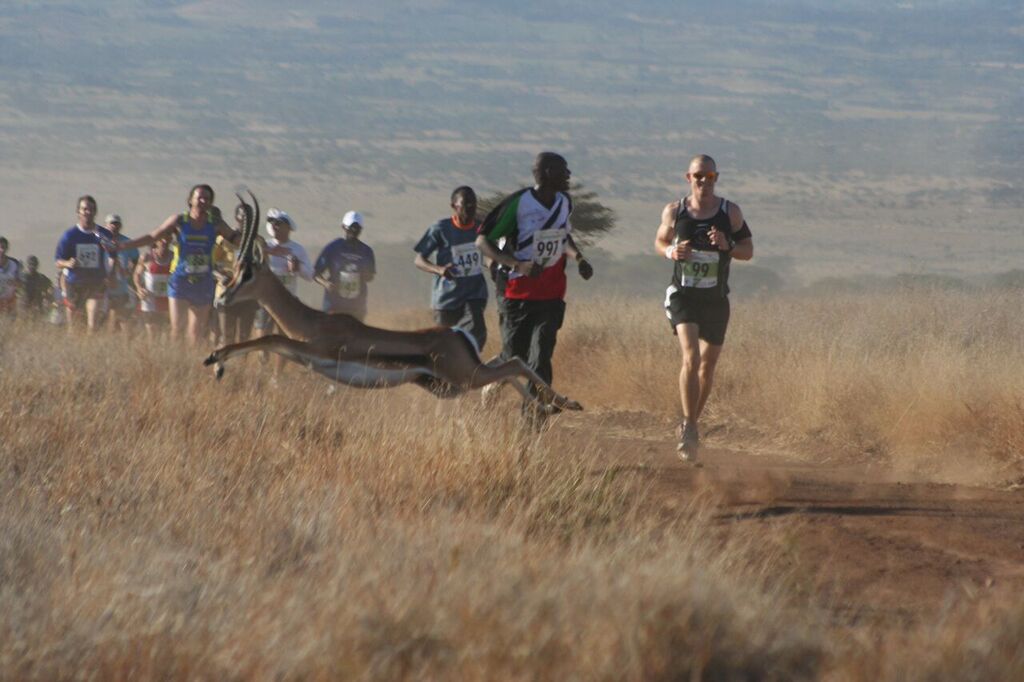
Kenya Marathon. Photo courtesy of Safari Com marathon.
7) Running For Rhinos In Kenya
If you don’t mind getting sweaty to save the rhinos, consider an unforgettable safari marathon at the Lewa Wildlife Conservancy in Kenya. In June, the Tusk Foundation — with Prince William as its royal patron — is hosting a world-renowned race where you can run alongside the animals you hope to save. After the marathon, runners go on gorilla treks courtesy of Aardvark Safaris, the event’s travel partner. Not only do the funds from your race protect animals, but you can visiting baby rhinos, partake in safari drives and enjoy eco-friendly luxury accommodations.
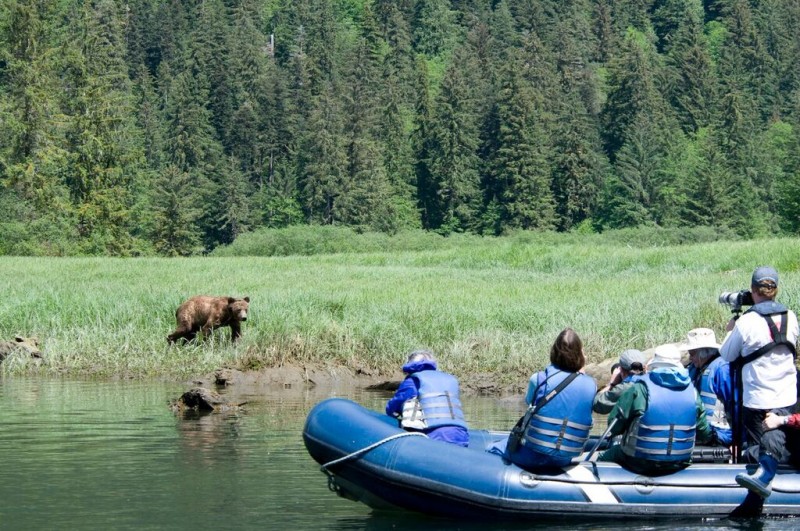
Grizzly sighting. Photo courtesy of Greg Shea/ Maple Leaf Adventures.
8) Protect Grizzlies Through A Bear Rainforest Ship Safari In British Columbia, Canada
Have you dreamed of encountering grizzlies in the wild? Maple Leaf Adventures provides an opportunity to glimpse the rare white spirit bear from the safety of a classical wooden schooner or tugboat, with proceeds of your trip benefiting conservation efforts. This boutique expedition cruise takes you through the Great Bear Rainforest in British Columbia, Canada, where bears, whales and wolves roam free through a vast expanse of fjords, islands and rainforests. Local crew and wildlife guides lead frequent short trips that include guided viewings in bear havens, rainforest walks, remote beach exploration, and visits to whale research stations and local villages. Groups are capped at 12 people, with everyone sleeping and dining aboard historic coastal ships, with meals that often incorporate fresh-caught ingredients.
Maple Leaf Adventures has been involved in the conservation of the Great Bear Rainforest since the mid 1990s, fighting hard to end the trophy hunting of grizzly bears. They also donate at least 1% of overall revenues to coastal conservation each year, and this trip includes donations to conservation research on whales and grizzly bears.
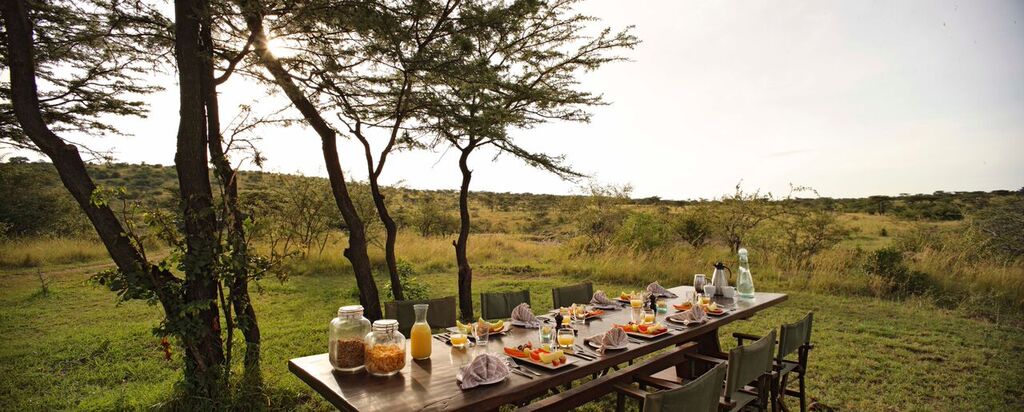
Breakfast on the lawn at Richards Safari. Photo courtesy of Richard’s Safari.
9) Safari Adventure To End Elephant Poaching In Kenya
If you’ve dreamed of game drives, birding and scenic bush walks, bush meals and cultural visits to Masai Villages, but want to make sure your visit promotes animal conservation consider staying at Richard’s Camps in the heart of Kenya’s Masai Mara National Park. This luxury camp has 70 acres of private land situated on the banks of the Njageteck River and regularly wins awards for its private and exclusive experiences. This resort also has started the Mara Elephant Project (MEP), which tracks the movements of the elephants while employing a Rapid Response Unit to quickly respond to conflict situations and poaching alerts.
MEP also educates the local Mara community by teaching human-elephant conflict resolution methods and providing anti-poaching education so locals can live alongside the elephant. Whether you participate in the yoga retreat or just visit Richard’s Forest or River Camp, you can book an MEP excursion. This will include a presentation by local experts about MEP activities and operations and a discussion of the Mara community issues that affect the elephant. You can meet the team of rangers, view the tracked (collared) elephants on Google Earth and potentially tour of the MEP head quarters.
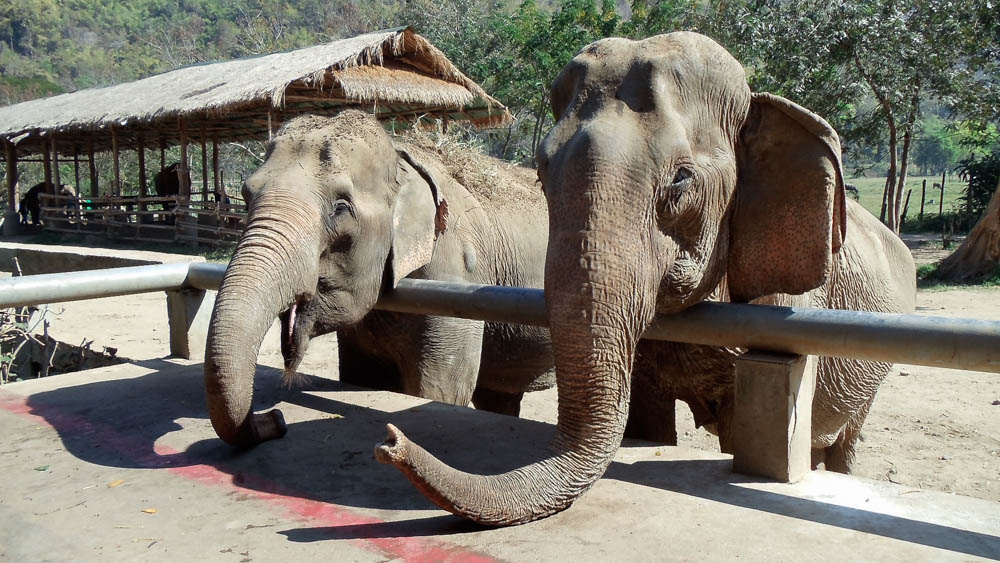
Beautiful elephants at Elephant Nature Park in Thailand
10) Volunteering At Elephant Nature Park In Chiang Mai, Thailand
Many tourists go to Thailand wanting to interact with elephants, but unfortunately they have no idea how abused the animals are. Many of the elephants that give elephant rides, paint or perform acts are poached out of the wild or bred in captivity, and are subjected to abuse to appease humans. Fortunately, there’s one place you interact with elephants in an ethical way: the Elephant Nature Park (ENP) rescue and rehabilitation center near Chiang Mai. ENP rescues elephants from horrendous and abusive situations and give them a place to live freely, have babies and form their own families.
This is one of numerous ethical Chiang Mai experiences. You can visit for the day or stay longer. Volunteer positions fill up months in advance, but if you’re lucky enough to snag one you can stay in a bamboo hut and work with the center. On any given day, you can help with bathing and feeding elephants, bagging elephant dung for a nearby organic farm and sharing the park’s mission with day visitors. Any money earned by the park goes right back to the elephants and those kept by locals who cannot afford proper medical care.

Jessica Festa is the editor of the travel sites Jessie on a Journey (http://jessieonajourney.com) and Epicure & Culture (http://epicureandculture.com). Along with blogging at We Blog The World, her byline has appeared in publications like Huffington Post, Gadling, Fodor’s, Travel + Escape, Matador, Viator, The Culture-Ist and many others. After getting her BA/MA in Communication from the State University of New York at Albany, she realized she wasn’t really to stop backpacking and made travel her full time job. Some of her most memorable experiences include studying abroad in Sydney, teaching English in Thailand, doing orphanage work in Ghana, hiking her way through South America and traveling solo through Europe. She has a passion for backpacking, adventure, hiking, wine and getting off the beaten path.








